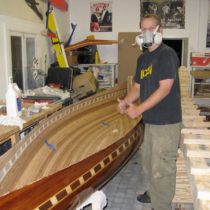Landscape Architecture for Landscape Architects › Forums › GENERAL DISCUSSION › Why Do You Hate New Urbanism?
- This topic has 1 reply, 13 voices, and was last updated 14 years, 6 months ago by
Tanya Olson.
-
AuthorPosts
-
January 13, 2010 at 3:18 pm #171625
 ncaParticipant
ncaParticipantSome of you may recognize this as a cross-post from my alter ego elsewhere..
Just an honest question.
Personally, I like some of the projects in my area even if duany supposedly hates landscape architects.
Your thoughts please..
January 13, 2010 at 5:00 pm #171674Tanya Olson
ParticipantThat Celebration is the poster-child for New Urbanism. gag.
I have to say I really like Stapleton, though. They had me sold with the allee of Quercus fastigiata and lots of grasses.
January 13, 2010 at 5:06 pm #171673 Ben YahrParticipant
Ben YahrParticipantAfter brushing up on the principles of new urbanism (http://www.newurbanism.org/), its tough to hate the concepts.
My problem is with TNDs that pop up as greenfield development taking funding, density, and emphasis away from true urban centers. Most of these new developments are on the periphery of an existing city so residents still end up driving for work, shopping, and entertainment. Better than culdesac sprawl, but certainly not achieving the goals of new urbanism.
January 13, 2010 at 5:55 pm #171672 ncaParticipant
ncaParticipantWhat about a TND that is 60 miles plus from the nearest major urban center?
I agree. I think the planning principles of NU are going in a very good direction. Asked the same question, architects tend to respond more to the architectural styling which they mostly detest rather than the planning.
With regard to greenfield development I’ll give you a Duany quote which I tend to agree with-
“The loss of a forest or a farm is justified only if it is replaced by a village. To replace them with a subdivision or a shopping center is not an even trade. – Andres Duany
The constant in my mind is that development WILL happen until the market will no longer support it. Environmentalism has it’s merits in the political sphere, but what can WE do as both designers and client reps to grow intelligently?
Is it realistic to rely on government subsidized commueter rail in the near future or should we look at alternatives and plan accordingly?
I’ll cross-post my reply from another forum on this topic as I think it’s appropriate again here-
The difficulty in that which I can see its that in places where new development is rampant you would need a’town center’ every 1/4 mile, or transit station, which isnt going to happen where there is true sprawl. I would consider the notion that low density is as appropriate as higher density depending on the context. This isn’t a urban site scale issue, but a regional planning issue, in which case I’d go out on a limb and say a lot of the regional planning being done in areas of rampant sprawl is 10+ years behind or totally politically charged.
The bottom line is ‘choice’ and variety’ is good. The problem with suburban sprawl isn’t the pattern itself, but the overabundance of a single pattern, which is inherently innefficient at the scale.
Thoughts?
January 13, 2010 at 5:57 pm #171671 ncaParticipant
ncaParticipantStapleton, yes the parkway planting is the best thing that projects got going for it in my opinion. Otherwise, I think the scale feels just huge and the parkway itself makes it feel even less walkable and disjointed in my opinion. I actually like *some* of the architecture though.
January 13, 2010 at 9:12 pm #171670 Ben YahrParticipant
Ben YahrParticipantSeems we are back to the age old argument that someone WILL be designing new housing, so it might as well be us- which makes sense. This also gets back to choice and variety- some people are set on living in the ‘burbs, some prefer dense urban areas. Ideally we can help provide well though out options for both, and ideally the American mindset will become a little more aware of the big picture sooner than later.
As much as I hope that we can get commuter rail lines in place, I don’t think that it’s realistic to plan on this happening “someday”. As you allude to, the industry and political framework is so entrenched in the ideas of the past that anything new is a hard sell.
I like your statement on patterns. I don’t necessarily agree with it, but it’s really making me think…
January 13, 2010 at 11:32 pm #171669 ncaParticipant
ncaParticipantBen-
Feel free to call me an idiot if you feel so inclined..I don’t mind. I’m trying to get a good, heated discussion going on urban planning. I played this topic on an architecture forum and it’s gone on and on, really good discussion, so I was hoping to plant the seed here and get a more focused landscape perspective.
As much as I enjoyed a lot of the discussions on sustainability and urbanism in the past I’d really like to have a discussion with more focus and hard data than getting lost in side topics.
Thanks for the good reponses..Hopefully we can get someone in here to chime in on the landscape urbanism front..
January 14, 2010 at 12:33 am #171668 Trace OneParticipant
Trace OneParticipantI hate new urbanism (big surprise..) It is garbage..Planning needs to occur at a much more general scale – draw the line on the urban center density, and stop there for new villages – go up,not out! within that core. And within that core, focus on banishing the car. The small scale interests of new urbanism drive me crazy – picket fences!! gack!! I specifically wrote into an ordinance the allowance for six foot high stockade fencing in the front yard – that front yard is your space!!! picket fences…gack!! Architectural review boards will be happy to rake you over the coals over the shape of your doorknobs…I think that is totally inappropriate.
We need to move WAY beyond new urbanism, into perhaps “ethical/environmental design.” what is the word….No cars…New urbanism is DEAD! But do NOT let architects talk about it – they all want Dubai..Gack, again!! Although only because it is in a desert..no water, no reference to local ecology for development guidelines..I would prefer high-rises, a la, Frank Lloyd Wright, in the urban core, to new urbanism..He was right on that.. But NOT in a DESERT..Build where there is water, for god’s sake!!
January 14, 2010 at 3:00 am #171667 ncaParticipant
ncaParticipantI don’t consider NU a replacement for metropolitan area. It’s an answer to suburban sprawl, not urban infill.
Are you talking about urban growth boundaries? If that’s the case I can attest to that not really working for areas like the Colorado Front Range. GMA’s still allow one town to grow to the edge of the next rural community.
January 14, 2010 at 7:16 pm #171666 Roland BeinertParticipant
Roland BeinertParticipantI haven’t seen too many new urbanist projects that really hold true to all the principles. It seems like people pick and choose the principles they like. Maybe I just haven’t seen enough NU projects, though.
January 14, 2010 at 11:38 pm #171665 Trace OneParticipant
Trace OneParticipantNIck, I see New Urbanism as indistinguishable (functionally) from suburban sprawl, and therefor not a good paradigm..Urban infill with growth boundaries are better answers… Actually New Urbanism combined with urban infill is an even better model, that will help prevent sprawl,maybe… That is sort of what happened in Tysons Corners II, in D.C..It was sprawl, and they tried to turn it into infill, after the density just connected everything..
The entire nature of our financing system for housing and construction needs to be revamped, with a focus on the zero-growth economy, and an economy that does not depend on construction to drive it..
Yes, I am an LA of the Star Trek generation..(With Picard as our captain..!)
🙂January 15, 2010 at 1:08 am #171664 Allan SabadoParticipant
Allan SabadoParticipantPart of my final project was actually based on New Urbanism. Before I started I was all about it, but then once I began to do more research on it, I began to realize its faults.
Don’t get me wrong its ideals and principles are great in theory, but I saw that sometimes it isn’t implemented properly, and in the end it fails. I’ve seen many examples around Georgia in person that have attempted New Urbanism Projects, but have never really been successful. One problem is location. Many of these New Urbanism projects are located in suburbia, far away from any major urban areas. If people want to visit or shop at these NU projects, they usually drive (completely contradicting one of its principles.) Another is housing prices. “Creation of multiple housing types that are affordable to encourage diversity and increase density,” are you kidding me? The prices at some of these places are INSANE, ranging from $300,000 to $600,000. These are only a couple reasons I’m against New Urbanism, and I have more.
Now don’t get me wrong, sometimes it is effective and can work. But most of the time I believe that it isn’t being applied properly. I think we should take these principles and apply them to already existing urban cities. I mean the “skeleton” for everything is already there. Public transportation, ability to walk, connectivity, etc…
That was what my whole project was really about, taking these New Urbanism principles and applying them to places where they can be effective.
January 15, 2010 at 3:38 am #171663 ncaParticipant
ncaParticipantThe point of adding this topic is to draw out some new ideas on urbanism, not necessarily to endorse any one philosophy, NU included.
For the most part Allan I agree with you. I think the planning priciples of NU are generally good ideas as ONE answer to suburban sprawl
As far as people driving to shop and dine in a nu community- I dont think that was really the designers intention in most cases. I’d bet, for the most part the retail components are added as a walkable service for the community members, not as a destination which I think is a pretty good idea as it also encourages community members to walk, interact and spend money in the local community. But I also think the street level scale and detailing probably make a big difference.
One of the primary reasons neighborhoods built in the style of NU are expensive is because the architecture is so varied, whereas a typical suburb has 2 or 3 models for several hundred or thousand units. Other things like alley loading, narrower streets, smaller setbacks, and good architectural programs in my opinion are good fundamental ideas.
I think it’s too bad that so many planners and architects shy away from NU just for the architectural styling or the purported ‘social engineering’ aspect.
Again, I dont necessariloy think NU is THE answer. I dont think I’m that naive. I’m trying to understand how many flavors of good urbanism there actually are and how to implement them realistically.
A lot of comments on NU also tend to go in the direction of regional planning issues. We dont always and rarely do in my limited experience have the ability to choose where a certain project goes, only what it can be.
I graduated feeling I had a pretty good grasp on urban planning and design priciples, but dismissed a lot of my inner idealism because I thought there MUST be some ‘magic’ to why a particular pattern is built in a particualr place and why the designer didnt choose to do something that could obviously be better. I’m pretty much convinced now that that magic doesn’t exist. We only do what we know as we go on in our careers and as we get further along it seems like we stick closer to what has worked in the past. Whether we like it or not LA’s have only ourselves to blame for sprawl.
Where are the ‘landscape urbanists?’
January 15, 2010 at 4:47 pm #171662 Trace OneParticipant
Trace OneParticipantNick, Landscape Arch’s who work as planners spend their entire lives worrying and working on where density belongs, so I disagree with your statement that we don’t get to choose where the projects go..Perhaps an individual project, but in working as a planner, as I said, it is your job to decide where stuff goes..I started to think about this in terms of Master Plans – I have been through two community Master Plan processes, after there had been no action on a new Master Plan for ten or so years..But I think Virginia actually has a mandated time frame for updating master plans.. Albemarle County Virginia has been supporting this really nasty growth plan designed along the major highway, Hwy 29..That has been reinforced at least twice in the past 15 years, by additional ordinances..So a normal planning job may entail four cracks at changing the ordinances, over your lifetime…
So we do get to work on this, and it is worth figuring out..
I also think a lot of the development pattern is built in by our federal tax incentive structure..That is something we as LA;s really have almost no control over..But that is where I think we need to change..Why are people encouraged, almost enticed, to buy new homes, to move to the burbs? Why are schools designed for thousands of students, to be bussed..It is all economics..January 19, 2010 at 2:00 pm #171661 ncaParticipant
ncaParticipantSure, I think you could argue that the govt has indirectly subsidized the real estate and housing construction industry for some time. I agree that the government or the American popular culture encourages and sometimes incentivizes home-buying and growth away from urban centers. Bu I think this is a bigger and separate issue.
I dont necessarily think suburban development is bad, but that the problem is its so consistently and repeatedly bad. I think theres a Keunstler quote in there somewhere. Not that I necessarily agree with him. I think if you keep talking, you’ll eventually say something intelligent. Otherwise, I think a lot of what Keunstler says misses the mark big time.
I realize planners in municipal positions in long range planning can affect large scale concerns, but I dont think they’re doing a very good job, OR there’s a political entanglement I’m not really aware of. The Colorado Front Range is littered, literally, with a sea of vanilla national home builder houses. Theres an obvious lack of foresight in long range planning between these towns. Obviously that model doesnt work. I think you’re agreeing with that.
Generally, I think the pattern needs to change. Growth will happen where it wants to happen I think. It IS about money and enhancing the value, whether perceived or actual, of the land. A vanilla product in a market full of vanilla isn’t a very sustainable model in my opinion. If growth wants to happen around the highways I think we need to be more adpative with how we plan our communities- the pattern is key because the planning isnt working.
-
AuthorPosts
- You must be logged in to reply to this topic.

